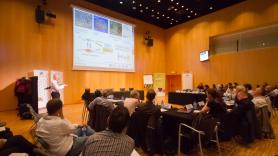2. Regenerative medicine as the base of research in the future
When we talk about stem cells and laboratory organs, we normally think of transplants and regenerative medicine. But the same tools that can be used to create new tissue are also a great source of hope for research.
“Most treatments today have been designed with the average patient in mind,” says Josep Samitier, director of the Institute for Bioengineering of Catalonia (IBEC) and one of the scientific leaders of this B·Debate. However, “this is changing with precision medicine, which takes into account the differences between individuals in terms of genetics, environment and lifestyle.”
iPS (induced pluripotent cells) are the great hope for regenerative medicine and offer new possibilities for the much sought-after precision medicine. These cells, obtained for the first time in 2006 (and which Japanese scientist Yamanaka won the Nobel Prize in Medicine for in 2012), take us back to our origins. By adding just four genes, we turn differentiated cells (adult cells, in a manner of speaking) from various tissues into cells that are practically embryonic, which are much more flexible and able to become almost any type of cell. This is a huge advantage in the era of personalized medicine because it means you can use the patient’s own cells, or those of patients with similar characteristics. This has been done by the team led by Ángel Raya, director of the Center of Regenerative Medicine in Barcelona, with Parkinson, analyzing different forms of the disease using iPS cells from the skin that have been transformed into neurons. This isn't without its problems, however, but Raya says, “The great advantage of this technique is that we can get the patient’s cells from when they were born, long before they developed the disease, and that allows us to recreate how it developed.”
Another complementary option, also based on pluripotent cells, is to recreate organs in the lab, simulating cell types and the structures they make up. This is one of the latest goals of regenerative medicine, but also of research itself, because it would allow the characteristics and environment of our tissues to be more faithfully reproduced. Although we are still far from creating functional organs, there are already small organoids of the heart, kidneys and even brain, among others, that are generally built by filling a three-dimensional structure with cells. James Kirkpatrick, professor emeritus in pathology at the Johannes Gutenberg University of Mainz, admits there are still difficulties in “the use of different cell types, like recreating vascularization and barriers,” the areas of exchange between organs. There’s also the question of size, “Without blood vessels, you have to feed them through diffusion and that means they have to be small,” says Samitier.
Another alternative is “organs-on-chips”, recreating the behavior of an organ in what is known as microfluid systems, small chambers filled with different types of cells that communicate amongst themselves and promises to overcome some of the difficulties of 3D organoids. For example, they can recreate physical forces like compression and reproduce cell-transport systems. As Roger Kamm, professor of Biological and Mechanical Engineering at MIT in Massachusetts, says, “They are true engineering systems, unlike organoids, in which nature is left to do its work.” Samitier believes these organs-on-chips “will be much more useful because they offer greater freedom and trials with more drugs, while organoids will surely be more relevant in regenerative medicine.” In either case, Kamm is both cautious and optimistic, “There are already models, but they need a lot of improvement. Pharmaceutical companies will end up adapting them in order to use them, but that’s still a long way off.”



